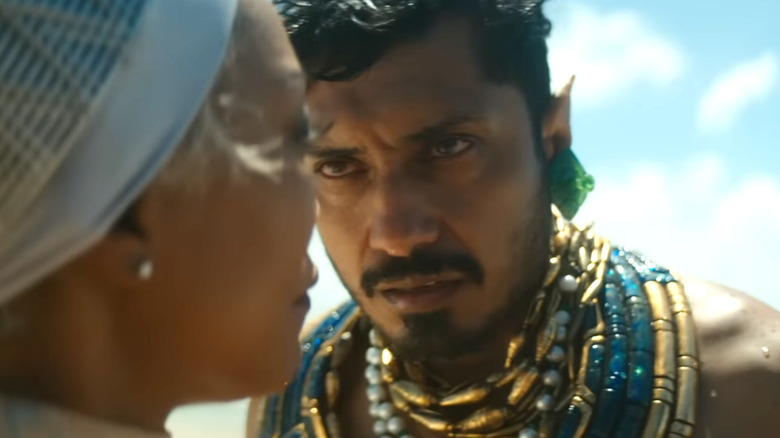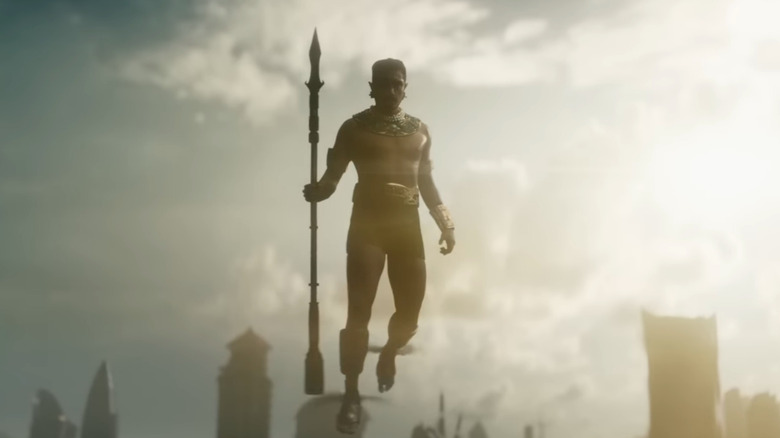Wakanda Forever Takes An Obscure Namor Trait & Makes It His Weakness
This article contains major spoilers for "Black Panther: Wakanda Forever"
"Black Panther: Wakanda Forever," the last theatrical feature film in Phase 4 of the Marvel Cinematic Universe, is finally in theaters. The movie not only follows up on the five years of shared universe storytelling that have taken place since the first "Black Panther," but it also introduces a villain familiar to long-time comic book fans: Namor, played by Tenoch Huerta. The underseas ruler has been floating around (literally) in the source material since the late 1930s, so his inclusion in the latest MCU entry was a joyous surprise for many fans.
However, comics readers will likely be taken aback by the MCU version of Namor. A lot has been changed in the adaptation from print to screen, especially when it comes to Namor's origin story and his powers. In the comics, Namor, the Sub-Mariner is the ruler of Atlantis, the mutant son of a human man and Atlantean woman who has fought alongside the X-Men and Avengers and helped found the Illuminati. His powers include elemental control of water and telepathy to control sea creatures.
"Wakanda Forever" reimagines Namor as the son of an indigenous Mesoamerican woman who, along with the rest of her village, drank a potion made from a plant fertilized with vibranium, which caused them to turn into the water-breathing Talocans. Afterward, they moved underseas to escape European colonization. Namor's mother was pregnant when she took the potion, and he was born as a mutant with the ability to breathe both air and water. His powers are also different in the movie. He can fly and has super strength, but while the Talocans can use whales as transportation, the animals don't seem to be at Namor's command.
But "Wakanda Forever" made another crucial change to Namor's powers, turning a minor weakness in the comics into his kryptonite equivalent.
Namor's weakness to being dry is far more important in the movie than the comics
It's a common comic book trope that beings who live underwater can't survive long on land. Aquaman — another half-Atlantean — can't be out of the water for too long, and his Marvel parallel, Namor, has a similar weakness. However, in the comics, Namor is rarely weakened by a lack of moisture, whereas "Wakanda Forever" makes it his kryptonite.
Namor's comic book variants are prone to manic-depressive mood swings when they spend too much time on land or in the water. Perhaps that's why the MCU version retreats to his above-water cave in Talocan when he's not needed underwater. And while some comic book storylines have shown that being dehydrated weakens him, "Wakanda Forever" takes that concept much further.
During the climax of "Wakanda Forever," Shuri (Letitia Wright) and Riri Williams (Dominique Thorne) deduce that drying Namor out will slow him down, so they turn the inside of a Wakandan airship into a dehydration chamber. During the ensuing battle, they lure Namor onboard the ship and turn up the heat, then drop him in the desert, causing Namor to become weakened enough for Shuri and her Black Panther powers to fight and defeat him.
Again, this form of attack against Namor isn't unheard of in the comics — the prime example being in "Incredible Hulk Vol. 1 #371," where Namor is weakened during a battle against Dark Hulk in New York City. But the concept is turned up to 11 for the final battle in "Wakanda Forever." By the end of his fight with Shuri, after being roasted in an explosion, he can barely pick himself off the ground.
By now, fans should understand that the MCU is a reality separate from the comic books it uses as inspiration. The way Namor is reimagined for the screen is only the latest example.

